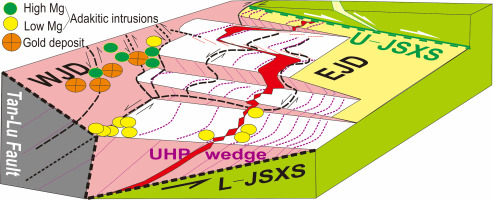当前位置:
X-MOL 学术
›
Gondwana Res.
›
论文详情
Our official English website, www.x-mol.net, welcomes your
feedback! (Note: you will need to create a separate account there.)
Timing of Triassic tectonic division and postcollisional extension in the eastern part of the Jiaodong Peninsula
Gondwana Research ( IF 7.2 ) Pub Date : 2020-07-01 , DOI: 10.1016/j.gr.2020.01.018 Hongyuan Zhang , Thomas Blenkinsop , Zhuowei Yu
Gondwana Research ( IF 7.2 ) Pub Date : 2020-07-01 , DOI: 10.1016/j.gr.2020.01.018 Hongyuan Zhang , Thomas Blenkinsop , Zhuowei Yu

|
Abstract The Jiaodong Peninsula is a key region for researching the interaction between the North and South China Plates. Tectonic relationships between collision, exhumation of ultra-high-pressure (UHP) slabs, strike-slip faulting and gold mineralization, are still ambiguous. The eastern part of the Jiaodong Peninsula (Eastern Jiaodong), which includes Triassic intrusions and is less affected by the Tan-Lu Fault Zone, is a key area to examine exhumation dynamics in detail. Systematic field mapping and zircon U–Pb dating of Triassic intrusions establishes that: (1) The UHP wedge in the eastern part of the Jiaodong Peninsula can be divided into the lateral and frontal ramps of a thrust and nappe system. Dating of samples from Donglinghou (244.7 ± 4.2 Ma) and Qingyutan (233.8 ± 8.1 Ma) areas indicates that the collision happened at or before the Middle Triassic. (2) Postcollisional extension intrusions including the Shidao granitoid (216.2 ± 2.4 Ma), and the Chengshantou granitoid (cut by a dolerite dyke dated at 210.5 ± 1.0 Ma), generally strike NE and occurred in a metamorphic core complex below the Upper Jiashan-Xiangshui detachment (U-JSXS). (3) Regional faults in the Jiaodong Peninsula exploited syncollisional foliations of the UHP wedge, which resulted in faults dipping towards the NW and SE. The reactivation of the Lower Jiashan-Xiangshui shear zone (L-JSXS) and its overprinting upon the Tan-Lu fault system may have caused another major episode of exhumation of the syncollisional wedge, and could have been responsible for an extensional environment that favored gold mineralization.
中文翻译:

胶东半岛东部三叠纪构造划分与碰撞后伸展时间
摘要 胶东半岛是研究华北板块与华南板块相互作用的重点区域。碰撞、超高压(UHP)板片折返、走滑断层和金矿化之间的构造关系仍然不明确。胶东半岛东部(胶东东部)包括三叠纪侵入体,受郯庐断裂带影响较小,是详细研究折返动力学的关键区域。三叠纪侵入岩的系统野外测绘和锆石 U-Pb 定年表明: (1) 胶东半岛东部的超高压楔可分为逆冲推覆系统的侧坡和锋坡。东陵侯(244.7±4.2 Ma)和青玉潭(233.8±8)样品的年代测定。1 Ma) 区域表明碰撞发生在中三叠世或之前。(2) 石岛花岗岩(216.2±2.4 Ma)、城山头花岗岩(被210.5±1.0 Ma的辉绿岩岩脉切割)等碰撞后伸展侵入体,大体向东北走向,发生在上嘉善下方的变质核杂岩中——响水支队(U-JSXS)。(3)胶东半岛区域性断裂利用超高压楔同碰撞叶理,导致断裂向NW和SE倾斜。下嘉善-湘水剪切带 (L-JSXS) 的重新活动及其在郯庐断裂系统上的叠加可能导致了同碰撞楔的另一次主要剥露事件,并可能导致有利于金的伸展环境矿化。(2) 石岛花岗岩(216.2±2.4 Ma)、城山头花岗岩(被210.5±1.0 Ma的辉绿岩岩脉切割)等碰撞后伸展侵入体,大体向东北走向,发生在上嘉善下方的变质核杂岩中——响水支队(U-JSXS)。(3)胶东半岛区域性断裂利用超高压楔同碰撞叶理,导致断裂向NW和SE倾斜。下嘉善-湘水剪切带 (L-JSXS) 的重新活动及其在郯庐断裂系统上的叠加可能导致了同碰撞楔的另一次主要剥露事件,并可能导致有利于金的伸展环境矿化。(2) 石岛花岗岩(216.2±2.4 Ma)、城山头花岗岩(被210.5±1.0 Ma的辉绿岩岩脉切割)等碰撞后伸展侵入体,大体向东北走向,发生在上嘉善下方的变质核杂岩中——响水支队(U-JSXS)。(3)胶东半岛区域性断裂利用超高压楔同碰撞叶理,导致断裂向NW和SE倾斜。下嘉善-湘水剪切带 (L-JSXS) 的重新活动及其在郯庐断裂系统上的叠加可能导致了同碰撞楔的另一次主要剥露事件,并可能导致有利于金的伸展环境矿化。和城山头花岗岩(被 210.5±1.0 Ma 的辉绿岩岩脉切割),一般走向 NE 并发生在上嘉善-湘水拆离(U-JSXS)下方的变质核杂岩中。(3)胶东半岛区域性断裂利用超高压楔同碰撞叶理,导致断裂向NW和SE倾斜。下嘉善-湘水剪切带 (L-JSXS) 的重新活动及其在郯庐断裂系统上的叠加可能导致了同碰撞楔的另一次主要剥露事件,并可能导致有利于金的伸展环境矿化。和城山头花岗岩(被 210.5±1.0 Ma 的辉绿岩岩脉切割),一般走向 NE 并发生在上嘉善-湘水拆离(U-JSXS)下方的变质核杂岩中。(3)胶东半岛区域性断裂利用超高压楔同碰撞叶理,导致断裂向NW和SE倾斜。下嘉善-湘水剪切带 (L-JSXS) 的重新活动及其在郯庐断裂系统上的叠加可能导致了同碰撞楔的另一次主要剥露事件,并可能导致有利于金的伸展环境矿化。(3)胶东半岛区域性断裂利用超高压楔同碰撞叶理,导致断裂向NW和SE倾斜。下嘉善-湘水剪切带 (L-JSXS) 的重新活动及其在郯庐断裂系统上的叠加可能导致了同碰撞楔的另一次主要剥露事件,并可能导致有利于金的伸展环境矿化。(3)胶东半岛区域性断裂利用超高压楔同碰撞叶理,导致断裂向NW和SE倾斜。下嘉善-湘水剪切带 (L-JSXS) 的重新活动及其在郯庐断裂系统上的叠加可能导致了同碰撞楔的另一次主要剥露事件,并可能导致有利于金的伸展环境矿化。
更新日期:2020-07-01
中文翻译:

胶东半岛东部三叠纪构造划分与碰撞后伸展时间
摘要 胶东半岛是研究华北板块与华南板块相互作用的重点区域。碰撞、超高压(UHP)板片折返、走滑断层和金矿化之间的构造关系仍然不明确。胶东半岛东部(胶东东部)包括三叠纪侵入体,受郯庐断裂带影响较小,是详细研究折返动力学的关键区域。三叠纪侵入岩的系统野外测绘和锆石 U-Pb 定年表明: (1) 胶东半岛东部的超高压楔可分为逆冲推覆系统的侧坡和锋坡。东陵侯(244.7±4.2 Ma)和青玉潭(233.8±8)样品的年代测定。1 Ma) 区域表明碰撞发生在中三叠世或之前。(2) 石岛花岗岩(216.2±2.4 Ma)、城山头花岗岩(被210.5±1.0 Ma的辉绿岩岩脉切割)等碰撞后伸展侵入体,大体向东北走向,发生在上嘉善下方的变质核杂岩中——响水支队(U-JSXS)。(3)胶东半岛区域性断裂利用超高压楔同碰撞叶理,导致断裂向NW和SE倾斜。下嘉善-湘水剪切带 (L-JSXS) 的重新活动及其在郯庐断裂系统上的叠加可能导致了同碰撞楔的另一次主要剥露事件,并可能导致有利于金的伸展环境矿化。(2) 石岛花岗岩(216.2±2.4 Ma)、城山头花岗岩(被210.5±1.0 Ma的辉绿岩岩脉切割)等碰撞后伸展侵入体,大体向东北走向,发生在上嘉善下方的变质核杂岩中——响水支队(U-JSXS)。(3)胶东半岛区域性断裂利用超高压楔同碰撞叶理,导致断裂向NW和SE倾斜。下嘉善-湘水剪切带 (L-JSXS) 的重新活动及其在郯庐断裂系统上的叠加可能导致了同碰撞楔的另一次主要剥露事件,并可能导致有利于金的伸展环境矿化。(2) 石岛花岗岩(216.2±2.4 Ma)、城山头花岗岩(被210.5±1.0 Ma的辉绿岩岩脉切割)等碰撞后伸展侵入体,大体向东北走向,发生在上嘉善下方的变质核杂岩中——响水支队(U-JSXS)。(3)胶东半岛区域性断裂利用超高压楔同碰撞叶理,导致断裂向NW和SE倾斜。下嘉善-湘水剪切带 (L-JSXS) 的重新活动及其在郯庐断裂系统上的叠加可能导致了同碰撞楔的另一次主要剥露事件,并可能导致有利于金的伸展环境矿化。和城山头花岗岩(被 210.5±1.0 Ma 的辉绿岩岩脉切割),一般走向 NE 并发生在上嘉善-湘水拆离(U-JSXS)下方的变质核杂岩中。(3)胶东半岛区域性断裂利用超高压楔同碰撞叶理,导致断裂向NW和SE倾斜。下嘉善-湘水剪切带 (L-JSXS) 的重新活动及其在郯庐断裂系统上的叠加可能导致了同碰撞楔的另一次主要剥露事件,并可能导致有利于金的伸展环境矿化。和城山头花岗岩(被 210.5±1.0 Ma 的辉绿岩岩脉切割),一般走向 NE 并发生在上嘉善-湘水拆离(U-JSXS)下方的变质核杂岩中。(3)胶东半岛区域性断裂利用超高压楔同碰撞叶理,导致断裂向NW和SE倾斜。下嘉善-湘水剪切带 (L-JSXS) 的重新活动及其在郯庐断裂系统上的叠加可能导致了同碰撞楔的另一次主要剥露事件,并可能导致有利于金的伸展环境矿化。(3)胶东半岛区域性断裂利用超高压楔同碰撞叶理,导致断裂向NW和SE倾斜。下嘉善-湘水剪切带 (L-JSXS) 的重新活动及其在郯庐断裂系统上的叠加可能导致了同碰撞楔的另一次主要剥露事件,并可能导致有利于金的伸展环境矿化。(3)胶东半岛区域性断裂利用超高压楔同碰撞叶理,导致断裂向NW和SE倾斜。下嘉善-湘水剪切带 (L-JSXS) 的重新活动及其在郯庐断裂系统上的叠加可能导致了同碰撞楔的另一次主要剥露事件,并可能导致有利于金的伸展环境矿化。











































 京公网安备 11010802027423号
京公网安备 11010802027423号